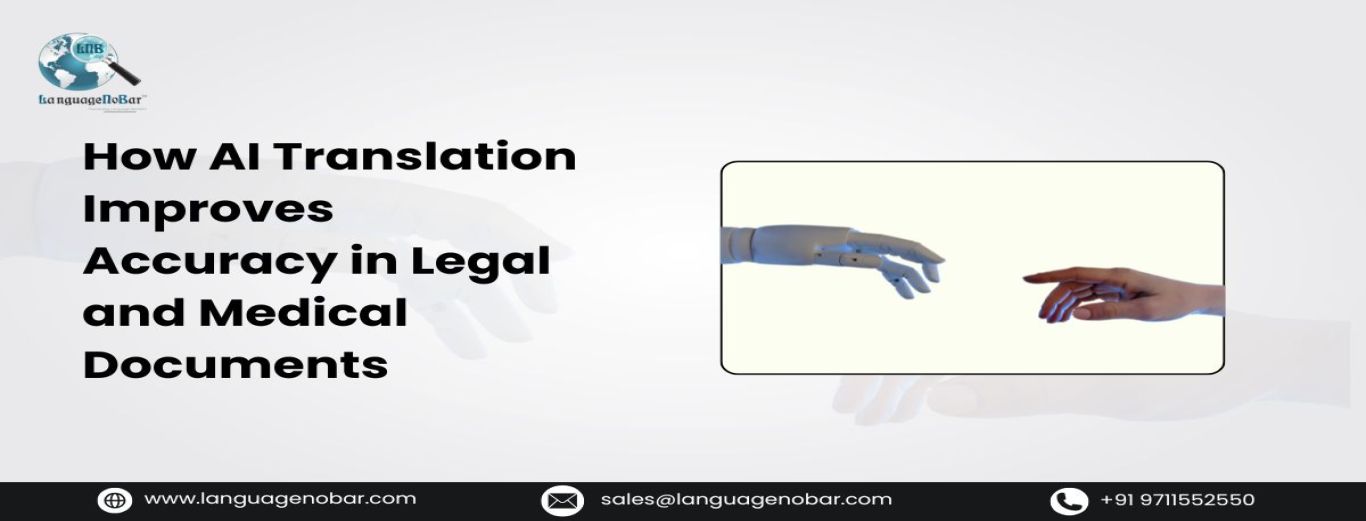How AI Translation Improves Accuracy in Legal and Medical Documents
- Blog
- Comments (0)
How AI Translation Improves Accuracy in Legal and Medical Documents
Critical documents like legal and medical documents are valued for their accuracy. The information is sacrosanct, and their translation must follow the highest standards. Document translation services often use their niche expertise to understand such technical documents, providing them with much-needed human oversight. However, AI is the new reality that is adding invaluable depth, speed, and accuracy to the translation. It is not limited to your humble Google translation you fiddled with while traveling inter-state. We would not even call AI the breakthrough in the field of translation in 2024 where AI is going much further than automated literal translations.
To AI or to not AI - When and Why
Traditional machine translations evolved from the last century have algorithmic models that follow a set of rules for translation. There was an absolute risk of errors in this as context can shift when words remain the same.
Deep learning systems or AI models, much like neural machine translation (NMT) have the ability to look beyond word-by-word translation while focusing on the context so it does not sound robotic. AI analyses the text, goes through vast data, and analyses language patterns before translating it. When your content is significantly heavy with repetitive jargon, this system is particularly handy.
Legal terms need to be consistent across jurisdictions in a country and have to maintain uniformity across several documents. Medical jargon is almost always universal, with highly specific terminology. AI identifies these terms and phrases to churn appropriate translations.
Terms like “prima facie” or “Force Majeure” are translated accurately because they are used frequently across similar documents and AI understands their relevance. AI often struggles with the colloquialism and tone of the document, which is not the main focus of medical and legal documents.
Both legal and medical documents are infamous for their content volume. AI grows, learns, and thrives on this large content. All machine learning and AI models are trained on vast amounts of data to attain lightning speed with huge-volume data.
Comparative advantages of AI translation
They handle volumes like a pro. Legal and medical documents can be endless as they tend to cover all details of the case in hand with zero information gaps. AI has the ability to crunch huge data in a short period, depending on the processing speed. Some models churn out 100 million words every year, not a simple feat.
They are low-cost for low-complex work. Whenever there is a low requirement of tone, wit, and cultural context. The cost can be almost half of what human translators charge, but the trade-off happens with quality. AI still has a lot of catchup to do while dealing with fluency and informality.
Voice translations and transcriptions, prominent in the medical sector, are already taken over by AI.
How will AI make document translation services better?
AI models are trained on niche-specific data. Now data is everywhere and is the new oil that powers AI models to improve their accuracy with every passing day. They use Natural Language Processing (NLP) to understand the source text within the given context and translate it effectively. The neural system of AI has several layers that translate the content.
Limitations of Using AI in Translation
Compared to human translations, AI translation still has some catching up to do. Thing like emotions - sarcasm or satire, is still something innocent AI still grapples with. However, in technical documents like legal and medical, these issues generally do not arise.
The AI model you are using is only as good as the data it was trained on. And just like the ocean, data on the internet is also filled with garbage. This becomes a critical concern during sensitive data and the document is something needed for decision making.
Translators in the legal and medical space often act as long-term partners to the clients as documentation is a process with multiple steps and tackling a few might not be exactly helpful. You will need a dedicated translator who will help you understand the nitty-gritty.
Will machine translations replace human translators?
The ideal answer is no, not in the short run at least. While it does show strength in increasing the speed and working well in repetitive environments, all professional legal translation services and medical translation services use a human to oversee any errors. This can be culturally sensitive and specific where the model is yet to be trained well on. These documents cannot afford even the tiniest of errors, so human intervention is imperative. Human translators can also understand the specific requirement so the AI can be directed accordingly rather than beating over the bush.
Image Credits:Market.us
How to take advantage of AI
There are some best practices for using your AI translation system. Using a combination of human professional translators who know how to churn out high volume without compromising on quality by leveraging AI will be ideal. Ensure that the model is trained with a regional dataset so it will understand the cultural context with better awareness of terms. Supplement your AI tools with glossaries containing culturally and jurisdictionally appropriate terms.
As always, trust is important in dealing with confidential documents such as legal or medical papers. Many free or cheap AI models do not guarantee any privacy for personal data. Study the AI model properly to prevent any privacy leakages






